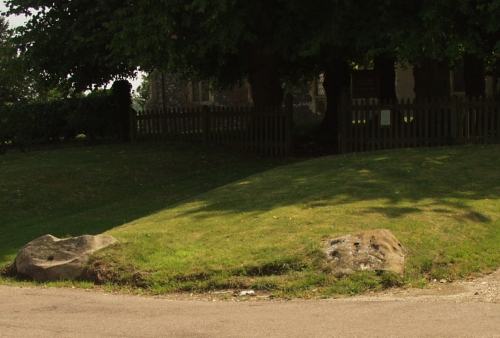The EH Scheduled monument record (31151) describes Popham Beacons thus:
The monument includes a round barrow cemetery prominently situated just north of the A303 and just west of the Stockbridge road, on a broad south east facing chalk spur. It consists of a linear arrangement of four very substantial round barrows and a saucer barrow oriented along the spur over a distance of about 185m. A sixth barrow, possibly a disc barrow, situated 20m to the south east, has been levelled by ploughing and is not included in the scheduling. Two further round barrows situated approximately 150m and 260m to the west, just on the other side of the Stockbridge road, have also been removed by ploughing and are also not included in the scheduling.
The most northerly barrow is a slightly elliptical bowl barrow, standing about 1.6m high with a maximum diameter of 25m, surrounded by a partially infilled ditch up to 5m wide and 0.2m deep. The second barrow lies approximately 12m to the south. It is a bell barrow comprising a central mound surrounded by a 3m wide berm, mutilated by rabbit burrowing and ploughing, and a partially infilled ditch up to 6m wide and 0.25m deep. The mound and berm are roughly circular and stand up to 2.4m high with a maximum diameter of about 26m. These features partly overlie a probable saucer barrow comprising a low central mound, about 0.2m high and 26m across, surrounded by a ditch, 5m wide and 0.1m deep, and an outer bank, 10m-12m wide and about 0.15m high. The fourth barrow also partly overlies the saucer barrow. It is a probable bell barrow comprising a roughly circular central mound, approximately 2.4m high and up to 24m across, with traces of a mutilated berm on the east and north east sides. It is surrounded by a ditch, approximately 6m wide and 0.15m deep. The fifth barrow lies about 5m to the south. This is a possible bell barrow comprising a roughly circular central mound, up to 2.4m high and 30m across, with traces of a mutilated berm. It is surrounded by a partially infilled ditch, 0.15m-0.25m deep, that is 5m-7m wide to the north and south but widens to 10m-12m wide to the east and west.
The three most substantial barrows are slightly hollowed in the centre indicating possible past excavation. The two to the north have exposed flint rubble cores while that to the south has an exposed core of chalk rubble. All have been clipped by ploughing and are disturbed by burrowing.
The monument is located on the alignment of a likely Roman road which survives 200m to the south east as a lane running along the edge of Black Wood and to the north west as discontinuous sections of farm track and woodland boundary.
Popham Beacons has been suggested, in a 1943 publication, to be the location of a Roman lookout station associated with this road, and have been identified on maps dating from 1595 as the approximate location of a later Armada beacon from which the monument gains its name. No archaeological evidence of any of these features survives however in the field within which the barrows are located.











